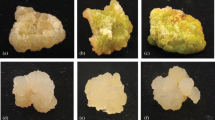Abstract
The effect of ultraviolet (UV-B) radiation on the accumulation and tissue localization of phenolic compounds in two strains of callus cultures of tea plant (Camellia sinensisL.) were investigated. The strains differed in their morphological and physiological characteristics and biosynthetic capacity. UV-B radiation hampered culture growth, decreased the size of callus-forming cells and promoted the accumulation of soluble and, to a lesser extent, polymeric forms of phenolic compounds, such as lignin. This accumulation was accompanied by an increase in the phenolic compound deposition in cell walls and intercellular space and by deposition of a lignin-like material on the surface of callus cultures. The strain characterized by an increased formation of phenolic compounds was more resistant to UV-B radiation as compared to that with lower phenolic productivity.
Similar content being viewed by others
REFERENCES
Blumthaler, M. and Ambach, W., Indication of Increasing Solar Ultraviolet-B Radiation Flux in Alpine Regions, Science, 1990, vol. 208, pp. 206-208.
Caldwell, C.R., Solar UV Irradiation and the Growth and Development of Higher Plants, Photophysiology, Giese, A.C., Ed., New York: Academic, 1971, vol. 6, pp. 131-177.
Shul'gin, I.A., Zabirov, R.G., Shcherbina, I.P., and Tolibekov, D.T., On the Role of Ultraviolet Radiation in the Structure of Shoots and Productivity of Wheats in the High Altitude Regions, Biol. Nauki (Moscow), 1990, no. 7, pp. 107-118.
De Lucia, E.H., Day, T.A., and Vogelman, T.C., Ultraviolet-B and Visible Light Penetration into Needles of Two Species of Subalpine Conifers during Foliar Development, Plant Cell Environ., 1992, vol. 15, pp. 921-929.
Fraikin, G.Ya., Some Problems of Current Ultraviolet Photobiology, Fiziol. Rast. (Moscow), 1987, vol. 34, pp. 712-719 (Sov. Plant Physiol., Engl. Transl.).
Nogues, S., Allen, D.J., Morison, J.I., and Baker, N.R., Ultraviolet-B Radiation Effects on Water Relations, Leaf Development, and Photosynthesis in Droughted Pea Plants, Plant Physiol., 1998, vol. 117, pp. 173-181.
Dawar, S., Vani, T., and Singhal, G.S., Stimulation of Antioxidant Enzymes and Lipid Peroxidation by UV-B Irradiation in Thylakoid Membranes of Wheat, Biol. Plant., 1998, vol. 1, pp. 65-73.
Rakitina, T.Ya., Vlasov, P.V., Zhalilova, F.X., and Kefeli, V.I., Abscisic Acid and Ethylene in Mutants of Arabidopsis thaliana Differing in Their Resistance to Ultraviolet (UV-B) Radiation Stress, Fiziol. Rast. (Moscow), 1994, vol. 41, pp. 682-686 (Russ. J. Plant Physiol., Engl. Transl.).
Stapleton, A.E., Ultraviolet Radiation and Plants: Burning Questions, Plant Cell, 1992, vol. 4, pp. 1353-1358.
Caldwell, M.M., Robberecht, R., and Flint, S.D., Internal Filters: Prospects for UV-Acclimation in Higher Plants, Physiol. Plant., 1983, vol. 58, pp. 445-450.
Zaprometov, M.N., Fenol'nye soedineniya: rasprostranenie, metabolism i funktsii v rasteniyakh (Phenolic Compounds: Distribution, Metabolism, and Functions in Plants), Moscow: Nauka, 1993.
Murphy, T.M., Hamilton, C.M., and Street, H.E., A Strain of Rosa damascena Cultured Cells Resistant to Ultraviolet Light, Plant Physiol., 1979, vol. 64, pp. 936-941.
Reuber, S., Bornmann, J.F., and Weissenbock, G., Phenylpropanoid Compounds in Primary Leaf Tissues of Rye ( Secale cereale ): Light Response of Their Metabolism and the Possible Role in UV-B Protection, Physiol. Plant., 1996, vol. 97, pp. 160-168.
Olsson, L.C., Veit, M., Weissenbock, G., and Bornman, J.F., Differential Flavonoid Response to Enhanced UV-B Radiation in Brassica napus, Phytochemistry, 1998, vol. 40, pp. 1021-1028.
Landry, L.G., Chaple, C.C., and Last, R.L., Arabidopsis Mutants Lacking Phenolic Sunscreens Exhibit Enhanced Ultraviolet-B Injury and Oxidative Damage, Plant Physiol., 1995, vol. 109, pp. 1159-1166.
Stafford, A., Natural Products and Metabolites from Plants and Plant Tissue Cultures, Plant Cell and Tissue Culture, Stafford, A. and Warren, G., Eds., Milton: Open Univ. Press, 1991, pp. 124-162.
Zaprometov, M.N., Biokhimiya katekhinov (Biochemistry of Catechins), Moscow: Nauka, 1964.
Zaprometov, M.N., Zagoskina, N.V., Strekova, V.Yu., and Morozova, G.A., Formation of Phenolic Compounds and the Process of Differentiation in the Callus Tissue of the Tea Plant, Fiziol. Rast. (Moscow), 1979, vol. 26, pp. 485-491 (Sov. Plant Physiol., Engl. Transl.).
Zagoskina, N.V., Fedoseeva, V.G., Frolova, L.V., Azarenkova, N.D., and Zaprometov, M.N., Tissue Culture of Tea Plant: Differentiation, Ploidy Level, and Formation of Phenolic Compounds, Fiziol. Rast. (Moscow), 1994, vol. 41, pp. 762-767 (Russ. J. Plant Physiol., Engl. Transl.).
Koretskaya, T.F. and Zaprometov, M.N., Tissue Culture of Tea Plant (Camellia sinensis) as a Model for the Study of Conditions Favorable for Phenolic Compound Formation, Fiziol. Rast. (Moscow), 1975, vol. 22, pp. 282-288 (Sov. Plant Physiol., Engl. Transl.).
Lapshin, P.V. and Butenko, R.G., Wheat Breeding for the Tolerance to UV-B Radiation Using the Cell Culture, Izv. Timiryazevsk. S-kh. Akad., Ser. Biol., 2001, no. 3, pp. 20-26.
Zaprometov, M.N., Phenolic Compound and the Methods for Their Investigation, Biokhimicheskie metody v fiziologii rastenii (Biochemical Methods in Plant Physiology), Pavlinova, O.A., Ed., Moscow: Nauka, 1971, pp. 185-197.
Bharti, A.K. and Khurana, J.P., Mutants of Arabidopsis as Tools to Understand the Regulation of Phenylpropanoid Pathway and UV-B Protection Mechanisms, Photochem. Photobiol., 1997, vol. 65, pp. 765-776.
Yavasaki, H., Sakihama, Y., and Ikehara, N., Flavonoid-Peroxidase Reaction as a Detoxification Mechanism of Plant Cells against H2O2, Plant Physiol., 1997, vol. 115, pp. 1405-1412.
Dixon, R.A. and Paiva, N.L., Stress-Induced Phenylpropanoid Metabolism, Plant Cell, 1995, vol. 7, pp. 1085-1097.
Author information
Authors and Affiliations
Rights and permissions
About this article
Cite this article
Zagoskina, N.V., Dubravina, G.A., Alyavina, A.K. et al. Effect of Ultraviolet (UV-B) Radiation on the Formation and Localization of Phenolic Compounds in Tea Plant Callus Cultures. Russian Journal of Plant Physiology 50, 270–275 (2003). https://doi.org/10.1023/A:1022945819389
Issue Date:
DOI: https://doi.org/10.1023/A:1022945819389




